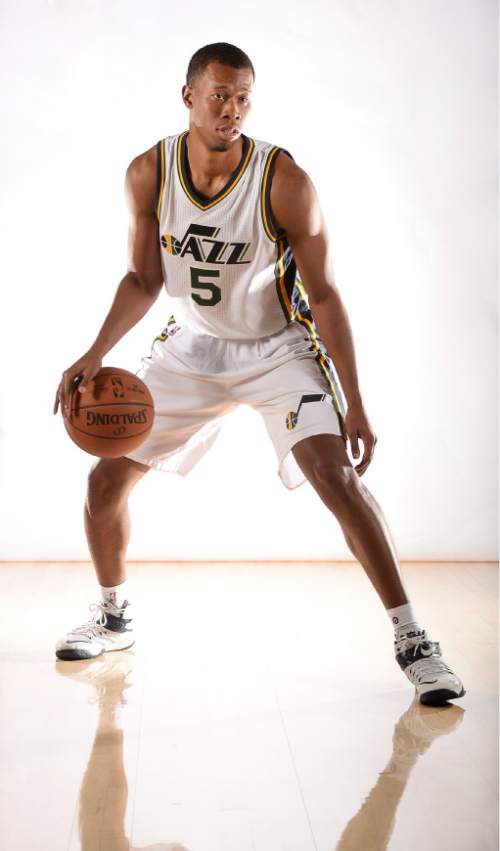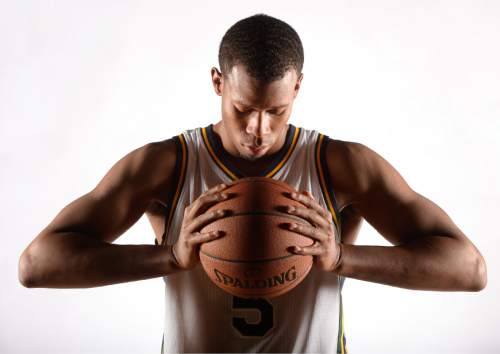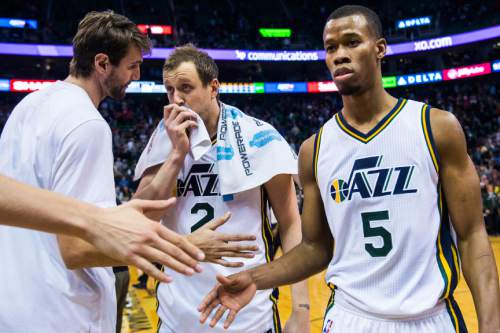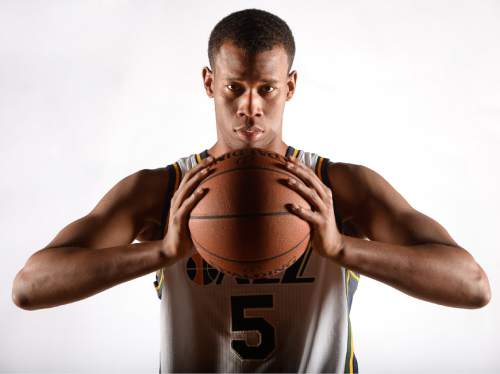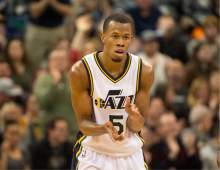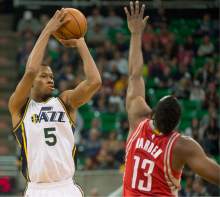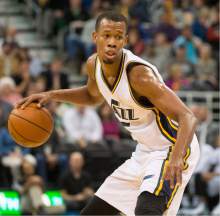This is an archived article that was published on sltrib.com in 2016, and information in the article may be outdated. It is provided only for personal research purposes and may not be reprinted.
This is not D.B. Cooper or Sasquatch or El Dorado's gold. But Utah Jazz shooting guard Rodney Hood is at the center of a mystery in the basketball world that even he hasn't been able to solve: Why, on that June night in 2014, as player after player marched across the stage to shake the commissioner's hand, was a skilled, 6-foot-8 shooting guard left sitting at his table for so long? How on earth did Hood, burgeoning star, fall to the Utah Jazz near the end of the first round?
"I still, to this day, don't know about the draft, about what happened," Hood says now.
And as Hood takes the court at All-Star Weekend, ready to compete against a crop of the NBA's top first- and second-year players (some of the latter who were drafted ahead of him), a few general managers have to be wondering the same thing.
Pros and cons
Friday night's contest at the Air Canada Centre will feature 20 of the league's best rookies and sophomores. "Rising Stars," the NBA calls them. And unquestionably, Hood is among the brightest. Over the first half of this season, the guard has started 49 games for the Jazz, eighth place in the West at the All-Star break, and averaged 14.9 points, 3.2 rebounds and 2.6 assists.
More and more, Hood is looking like the steal of his draft.
Few, if any, experts — and certainly not Hood himself — expected the shooting guard to fall to the Jazz at 23. In the run up to the draft, Hood declined an invitation to work out for the Jazz. He didn't work out for any team picking lower than 18, and even then it was because the Phoenix Suns owned both the 14th and 18th picks.
But on draft night, other preferences won out.
In Sacramento, owner Vivek Ranadive was enamored by the shooting stroke of Michigan guard Nik Stauskas, who the Kings shipped to Philadelphia before the start of this season. The Phoenix Suns grabbed T.J. Warren, a high-scoring wing out of North Carolina State and one of the few bright spots for the Suns this season (before suffering a season-ending leg injury, anyway), with the 14th pick. The Celtics preferred upside with the 17th pick and drafted Kentucky freshman James Young, who has been a frequent D-League assignee in his first two seasons. In Memphis, UCLA guard Jordan Adams, a favorite of the analytics crowd, was the pick at No. 22.
So why did Hood fall all the way to the Jazz at No. 23, the 10th wing player to come off the board? Utah general manager Dennis Lindsey has chalked it up to luck, and good luck at that.
There were, of course, other factors involved:
• Physical attributes: At 6-foot-8, Hood has terrific size for a two-guard, but he has a slight frame, weighing just over 200 pounds at the NBA pre-draft combine. Hood's 6-foot, 8.5-inch wingspan is shorter than the rangy wings front office execs envision patrolling the perimeter of a defense. To a lesser extent, teams might have been leery of Hood's flat feet. Although he did not have a history of injury in college, Hood did have to battle foot ailments that cost him nearly half of his rookie season. He has been largely injury-free in his sophomore campaign, however, which he attributes to wearing better-fitting shoes, new orthotics and speciality exercises.
• Age: Hood entered the draft after his redshirt sophomore year. He started his collegiate career at Mississippi State before transferring to Duke, which forced him to sit out a year. Even though his 21 years earned him the right to buy himself a celebratory drink on draft night, it also may have cost him with NBA executives who love the upside and potential of youth.
• Limitations: At Duke, Hood averaged better than 16 points a game and shot better than 40 percent from beyond the arc. But his defense left much to be desired, and offensively he did not often get to show off what would become perhaps his best NBA skill: running the pick-and-roll. In his relatively few chances, Hood was the most efficient pick-and-roll player in college basketball that year — something the Jazz keyed on.
'Draft him'
It didn't take long for the Jazz to figure out they drafted an offensive weapon. Hood is a tall guard with the ability to see over defenses and read the floor, and as a former point guard, he has the ball-handling skills and mid-range game to dice up opposing defenses. This season, Hood is in the 85th percentile when it comes to pick-and-roll ball-handlers, according to the NBA's data.
He has become one of Utah's go-to options in the clutch. "Coming in, I couldn't imagine myself being in this role in my second year," Hood admitted. But his skill set and chemistry with Gordon Hayward on the wing has started to form Utah's most potent one-two punch.
"I think it has just spread out our attack, given us more looks," Hayward said. "Because he's left handed, it gives us a different look on either side of the floor with our dominant hand. It's just harder to guard us."
Added Hood, "We're getting better and better each game, especially at the end of games. Whoever has the mismatch — sometimes he might tell me to get the ball, some games I might tell him to be aggressive at the end of games — we're getting better and better at that."
Even on draft night, Jazz officials had an inkling of what Hood might become, and they had the guard rated among their top 15 choices. When Hood fell to them at 23, they were overjoyed, though Jazz coach Quin Snyder said he did make a phone call before the pick was made. Snyder, a former Duke Blue Devil himself, said he called Duke coach Mike Krzyzewski to ask about Hood.
"Coach K was in New York. I think I got him out of dinner," Snyder recalled. "And he said, 'Draft him,' which was kind of how we felt too."
No doubts
A year and a half later, Hood is making that call look good and continuing to improve. Over his past 10 games, he is averaging better than 20 points and shooting 40 percent from 3.
You only have to go back to Tuesday night in Dallas to see how important Hood has become to the Jazz's future. Hood scored 15 points in the second half to help fuel a Jazz rally. In the fourth quarter, the lanky guard took advantage of a mismatch to get a pair of pull-up buckets in the paint. And when the Jazz needed a 3-pointer to force overtime, the ball found its way into Hood's hands in the corner, with the clock nearing zero.
Back in Hood's hometown of Meridian, Miss., the high school's head varsity coach, Randy Bolden, watched as he does with every one of his star player's games — and he knew Hood's shot was going in.
"No doubt," he said. "No doubt about it."
The same could be said of Bolden's belief in Hood on draft night, as he sat with the guard and his family in front of the stage at Barclays Center, awaiting when Hood's name would be called.
"He was still poised," Bolden recalled. "[But] the whole time, our train of thought was that the people that are passing him up are definitely going to regret it down the road. I think that's starting to come true now."
Twitter: @tribjazz


